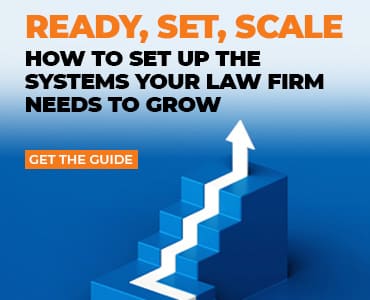A few months back, I was drowning in work. Every available space on my calendar seemed to be filled with other people’s priorities.

Table of contents
- What Worked? 5 Attorney Productivity Tips to Maximize Billable Hours
- 1. Time Blocks for Email
- 2. No Meetings on Mondays
- 3. Batching Calls on Fridays
- 4. Checking in With My Future Self
- 5. Implementing a Shutdown Routine to Manage Non Billable Tasks
- Scheduling Deep Work
- Time Tracking
- Now Go Be More Productive (and Less Stressed in the Process)
- More Attorney Productivity Tips to Try for Professional Development
While it’s good to be busy, it’s not when you get to the point where things start slipping through the cracks. So I started focusing intently on finding ways to improve my productivity within my law firm.
What Worked? 5 Attorney Productivity Tips to Maximize Billable Hours
I experimented with all kinds of productivity “hacks” to improve law firm productivity, and most were more trouble than they were worth. However, five really moved the needle in a positive direction. Here they are, in case you’re looking for a productivity boost, too.
1. Time Blocks for Email
Instead of checking and responding to every new email notification — which is how I used to deal with email — I started creating two 30- or 45-minute blocks of time every day to process email.
Automating repetitive tasks, such as sorting emails, can also free up more time for deep work.
Ideally, these are the only times I’m going in my inbox.
By creating time blocks, I have time set aside to work on nothing but email. This allows me to do more and better deep work during the rest of the day.
And I don’t think my clients notice any difference. After all, they want a timely response back from me — almost never an instantaneous one. Plus I think they prefer me spending more time concentrating on creating good work product for them versus immediately responding to emails.
2. No Meetings on Mondays
Everyone has heard that it’s best to get your most important and challenging work done first thing in the morning when your mind is fresh. In the legal industry, uninterrupted time is crucial for handling complex legal tasks effectively.
I started taking that one step further by reserving all day on Mondays for deep work like writing and strategy — which means having no meetings on Monday.
Many times it feels like I get more work done on Mondays than the rest of the week combined.
This helps build momentum that carries me through the rest of the week.
3. Batching Calls on Fridays
While I try to start off the week with a deep-work bang, my creative energy to dive into a project is often sapped by the time Friday rolls around. So that’s the day I try to batch as many back-to-back calls as possible. By focusing on the same task, such as making calls, you can maintain a higher level of concentration and efficiency.
Variety may be the spice of life, but it’s a productivity killer. So when I’m writing, I want to write. And if I’m connecting with people on calls, I want to connect. Switching back and forth (while sometimes inevitable) can be a big distraction.
4. Checking in With My Future Self
While my current self may feel stressed and tired, I have a tendency to believe that my future self (me two months from now) will have lots of capacity and boundless energy. As a result, I sometimes have a tendency to say yes to commitments in the future that I would say no to if they were happening tomorrow.
To correct for this, I committed to not saying yes to any new commitment until after a 24-hour period has passed. This gives me a chance to check in with my future self and make an honest assessment if I want to say yes to a future request on my time. The answer has been “no way” more often, which has been a relief to my current and future self!
5. Implementing a Shutdown Routine to Manage Non Billable Tasks
A productive day is enabled by a good morning routine, which is enabled by a good night of sleep, which is enabled by detaching from the stress of the workday.
And detaching from the stress of the workday is enabled by a good shutdown routine at the end of the day. A good shutdown routine also includes time for professional development, ensuring you stay updated and efficient in your role.
Since the boundary between work and life is blurrier than ever, a shutdown routine is more important than ever. Every day, leaving my office, I devote 15 to 20 minutes during which I do this:
- Tie up loose ends.
- Do one last review of email.
- Note priorities for tomorrow.
- Set an intention for the evening.
- Close the laptop and step away from my desk.
This routine — like a checklist for a pilot — helps me walk away from work feeling squared away.
I’m less stressed, more present for others and sleep better. As a result, I’m more productive the next day.
No, my routine isn’t perfect — and yours probably won’t be either. Yes, it’s sometimes necessary to jump back on the computer at night to respond to messages. But don’t let the pursuit of perfection get in the way of progress. Establish boundaries to the best of your ability.
Scheduling Deep Work

In today’s law firms, finding time to focus on complex legal work can be tough. That’s where deep work comes in. Deep work is about dedicating time to concentrate on hard tasks without distractions, which is necessary for good legal work.
To make deep work a habit, start by identifying the tasks that require your full attention. These might be drafting complex legal documents, developing case strategies or doing thorough legal research. Once you’ve identified those tasks, schedule specific time slots in your calendar for deep work sessions.
During these sessions, turn off notifications, close your office door and tell your colleagues about your deep work hours. Also schedule these sessions when you’re most focused and alert, like in the morning.
Get your whole team to do this. Taking breaks between deep work sessions can help you recharge and stay productive throughout the day. By doing deep work, law firms can deliver better legal services, meet client expectations and be more productive.
Time Tracking

Time tracking is the foundation of productivity in many law firms. It’s not just for billable hours but also to see how time is spent across tasks and projects. This data is key to performance evaluation, decision making and process optimization.
To track and record time effectively consider using a centralized time tracking system. This should be user friendly and accessible to all attorneys and staff. Training your team on time tracking procedures is key to consistency and accuracy.
Reviewing and analyzing time tracking data regularly can reveal trends and areas for improvement. For example you may find that non billable tasks are taking longer than expected and you can adjust your workflow accordingly. This data can also inform billing practices so you can provide transparent and accurate invoices to clients.
By using time tracking tools law firms can improve productivity and client satisfaction through accurate billing and resource allocation. Time tracking is a small investment that can pay big dividends in the long run and drive your law practice forward.
Now Go Be More Productive (and Less Stressed in the Process)
That’s what’s working for me these days — five simple tips to make you more efficient and productive.
I hope this is helpful if you’re looking for a boost in productivity, too.
More Attorney Productivity Tips to Try for Professional Development
There’s no bigger contributor to unhappiness and stress than the sense you’ve lost control. Here are more attorney productivity tips to help you get the most out of your day. These tips can help you build a more effective law practice.
- Four Productivity Building Blocks of Effective, Efficient and Happy Lawyers
- Why Are You at the Office Until 10 p.m.?
- 5 Ways to Get More Free Time Each Day
Illustration ©iStockPhoto.com
















